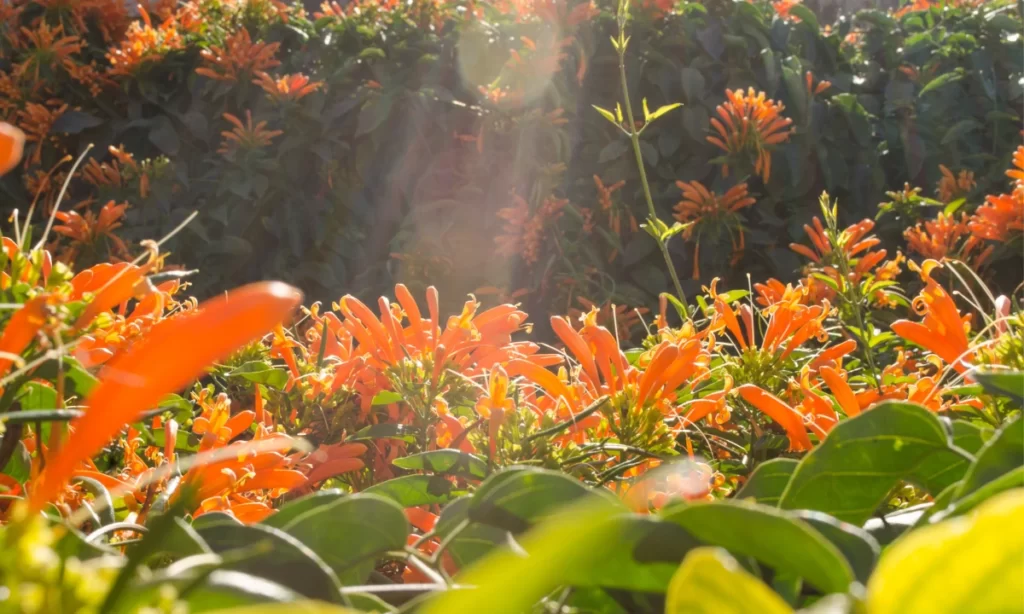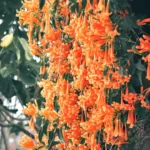Overview of Flame Vine (Pyrostegia venusta)
Description of Flame Vine
The flame vine, also known as Pyrostegia venusta, is a beautiful flowering vine native to Brazil. It is an evergreen, twining liana that can grow up to 30 feet long. The flame vine is highly admired for its clusters of vibrant orange-red tubular flowers that bloom in winter and spring. The flowers emerge from woody stems and glossy green leaves that can be up to 6 inches long. When in full bloom, the flame vine creates a spectacular floral display that looks like a river of fire. For this reason, it is also nicknamed the flaming trumpet vine, orange trumpet vine, and firecracker vine. The flowers attract hummingbirds and butterflies to the garden. Once established, flame vines grow vigorously and bloom heavily year after year in frost-free climates.
| Name | Flame Vine |
| Common Names | Pyrostegia Species, Flame Vine, Golden Shower, Orange Trumpet Creeper, Cipo-Sao-Joao |
| Origin | Native to Brazil, Bolivia, northeastern Argentina, and Paraguay |
| Type | Creeper |
| Outdoor/Indoor | Outdoor |
| Soil | Well-drained soil |
| Flowers | Long, bright orange flowers |
| Blooming Season | Winter to Spring |
| Height | Up to 5-6 Feet |
| Temperature | 15-35°C |
| Watering | Plenty |
| Sunlight | Full sun with a preference for 6-8 hours of sunlight |
Here are some common names for Flame Vine in different Indian languages:
Hindi: अदरक बेल (Adrak Bel)
Bengali: লাল গোলাপ লতা (Lal Golap Lata)
Tamil: பூந்தொண்டு (Poonthondhu)
Telugu: అంగూరు పుల గడ్డ (Angooru Pula Gadda)
Kannada: ಅಕ್ಕಿಮರ ಹೂ (Akkimara Hoo)
Malayalam: കാട്ടുമുള്ളി (Kaattumulli)
Marathi: शेवग फूल (Shevag Phool)
Gujarati: અદૂસીયા ની લતો (Adoosia Ni Lato)
Punjabi: ਅਦਰਕ ਵਾਇਨ (Adrak Wain)
Odia: କିମି ଫୁଲ (Kimi Phula)
Native Region and Habitat
Flame vine is native to subtropical and tropical regions of Brazil. It thrives in humid, warm environments and is found growing up trees and structures in forests, woodlands, and along river banks in its native habitat. Flame vine can grow in both full sun locations and partial shade.
Growing Conditions

- Flame vine prefers warm temperatures, consistently above 60 degrees Fahrenheit.
- It can withstand brief drops to 30 degrees F but sustained cold will damage the vines.
- Flame vine thrives in zones 9-11 and can be grown as an annual vine in cooler climates.
- It grows best in well-draining, acidic to neutral pH soil that is moderately fertile.
- Flame vine needs a tall support structure or tree to climb up since it can reach 30 feet in ideal conditions.
- It also requires ample moisture during the growing season but soil should not stay soggy.
- Humidity supports vigorous growth.
Growing Flame Vine

Propagation from Cuttings
- The easiest way to propagate flame vine is from stem cuttings.
- Take 6-8 inch tip cuttings from healthy vines in spring or summer.
- Remove the leaves from the bottom half of each cutting.
- Dip the bottom of the cuttings in rooting hormone powder to encourage root growth.
- Plant the cuttings in sterile potting mix, sand, or a combination.
- Water the cutting well and cover with a plastic bag to create humidity.
- Keep the cuttings warm, around 70-80 degrees F. Rooting can take 4-8 weeks. Gradually introduce the cuttings to normal humidity levels once roots are established.
- Transplant the rooted flame vine cuttings into pots or the garden.
Propagation from Seeds
- Flame vine can also be started from seeds.
- Collect seeds when the seed pods split open in late spring or summer.
- Store seeds in a paper envelope in a cool, dry location over winter.
- In early spring, plant seeds 1⁄4 inch deep in starter trays with seed starting mix.
- Keep the soil evenly moist and provide bottom heat of 70-75 degrees F.
- Germination usually occurs in 2-3 weeks but can be erratic.
- Transplant the flame vine seedlings into 4 inch pots once they grow 2 sets of leaves.
- Grow the seedlings on at 65-75 degrees F and gradually introduce them to normal outdoor conditions.
- Plant the vine seedlings into the garden after all danger of frost has passed.
Transplanting Flame Vine
- Flame vines that are started from cuttings or grown from seeds should be transplanted into the garden once nighttime temperatures stay above 50 degrees F.
- Select a sheltered location protected from wind and frost.
- Dig a hole twice the width of the pot and to the same depth.
- Gently remove the vine from its pot, loosen the roots, and place it in the planting hole.
- The top of the root ball should be level with the surrounding soil.
- Fill in around the vine with soil, tamping down gently to remove air pockets.
- Water thoroughly after planting and cover the root zone with mulch.
- Stake or trellis the young flame vine to provide growing support.
Caring for Flame Vine

Sunlight
- Flame vine thrives in full sun to partial shade.
- In tropical zones, provide at least 6 hours of direct sunlight per day.
- In cooler regions, choose a location with maximum sunlight and protection from wind.
- Morning sun with afternoon shade is ideal.
- Insufficient sunlight will result in sparse flowering.
Soil
- Flame vines need well-draining soil to avoid root rot.
- Amend clay or sandy soils with compost to create an evenly moist, loamy texture.
- The ideal pH range is 6.0-7.0.
- Improve drainage in heavy soils by planting flame vine on a mound or slope.
- Adding organic material like compost, peat moss, or rotted manure provides nutrients for growth.
- Mulch around the vine to conserve moisture and suppress weeds.
Water
- Consistent moisture is vital for flame vines during the growing season.
- Water whenever the top few inches of soil become dry.
- Provide 1-2 inches of water per week from rainfall or irrigation.
- Reduce watering in winter when the vine goes dormant but do not allow soil to completely dry out.
- Container grown flame vines need more frequent watering.
- Poor drainage can lead to root rot and decline of the vine.
Temperature
- Flame vine thrives in warm temperatures between 70-85°F and cannot tolerate frost or freezing.
- Temperatures below 30°F will damage the vine.
- In zones 9-11, flame vine will remain evergreen year round. In cooler areas, provide protection or treat it as an annual.
- Move potted vines indoors before frost in fall.
- Insulate vines growing on structures with frost cloth.
- High heat and intense sunlight can scorch the leaves, so provide afternoon shade in very hot climates.
Pruning
- Prune flame vine in late winter or early spring before new growth begins.
- Remove dead stems or branches and thin overcrowded growth to improve air circulation.
- Cut back excessively long vines to manage size.
- Prune damaged or diseased vines down to healthy wood.
- Always sterilize pruning tools before use.
- Regular pruning keeps vines growing vigorously and producing more flowers.
Training and Support
- Flame vines use tendrils to cling onto structures but also need to be trained for optimal growth.
- Provide sturdy support early in the growing season when vines are young and flexible.
- Use plant ties to guide vines up trellises, arbors, fences or trees. Space out vines and avoid overcrowding.
- Weave vines through trellis grids or in between branches.
- Prune vines as needed to remove unruly growth.
- Monitor support structures to ensure they are not damaged by vigorous flame vines.
Fertilizer
- Apply balanced fertilizer or compost around flame vines in early spring when new growth appears.
- Use a 10-10-10 or bloom-boosting formula. Follow package instructions to determine correct amount based on vine size and age.
- Fertilize the flame vine every 6-8 weeks during the growing season to encourage flowering.
- Excess nitrogen can lead to foliar growth instead of blooms. Discontinue fertilizer after September.
Pests, Diseases, and Problems

- Aphids, scale, and mealybugs will attack flame vine. Use insecticidal soap, neem oil, or horticultural oil sprays to control infestations before they escalate.
- Powdery mildew fungal disease causes a white powdery coating on leaves. Improve air circulation and use fungicides to treat it early.
- Root rot due to overwatering or poor drainage. Allow soil to dry between waterings and improve drainage conditions.
- Frost damage results in wilting, dieback, and discolored leaves. Protect vines with coverings when frost is expected.
- Insufficient flowering can be due to overfertilizing, overpruning, or not enough sunlight. Troubleshoot cultural care and make adjustments.
Uses for Flame Vine

As An Ornamental Vine
With its brilliant orange-red blooms, flame vine is ideal for decorating pergolas, arbors, trellises, and fencing. It can create colorful vertical accents on walls and posts.
Flame vine also enhances tropical garden beds and borders. Use it to add color to outdoor living spaces like patios, decks, and pool areas.
Plant flame vine near seating areas so the vibrant flowers can be admired up close. Combine it with blue or purple flowers for stunning contrast. Grow flame vine in large containers on decks and patios.
Medicinal Uses
Flame vine has some medicinal benefits in Brazilian herbal medicine.
The leaves are used to brew fever-reducing tea. Flame vine leaf tea is also consumed for its sedative effects to promote relaxation and sleep.
Compounds in the plant are believed to have diuretic, antispasmodic, and analgesic properties.
More research is needed to determine the efficacy and safety of flame vine for medicinal use.
Summary

The flame vine is an outstanding ornamental plant that provides vibrant color and tropical appeal to gardens, landscapes, and containers. With its brilliant display of tubular orange flowers, it lives up to its name as a fiery vine. By providing the proper growing conditions and care, gardeners can successfully cultivate flame vine to enhance outdoor living spaces with its cascading floral show. Its versatility and low maintenance make flame vine a rewarding addition to gardens in warm, humid climates.
FAQs About Growing Flame Vine
What is the best way to grow flame vine?

Flame vine is easily propagated from cuttings or grown from seeds. Mature vines can also be transplanted. Ensure flame vine has sturdy support for optimal growth.
What are the ideal growing conditions for flame vine?

Flame vine needs full sun, warm temperatures from 70-85°F, evenly moist well-draining soil, and humidity. Shelter from wind and winter frost is essential.
How do I get my flame vine to flower more?

Maximize sunlight exposure, avoid overfertilizing with nitrogen, provide support for growth, and prune judiciously to encourage flame vine flowering.
What does flame vine look like when not in bloom?

Flame vine has long, flexible green stems and glossy green, elliptical leaves. It will remain evergreen in frost-free climates but can lose leaves in winter in cooler zones.
Is flame vine suitable for containers?

Yes, flame vine can be grown in large containers on decks, patios, and near entryways given adequate support. Provide well-draining potting mix and maintain consistent moisture. Move containers to protected areas in winter.

2 thoughts on “How to Grow Flame Vine | Pyrostegia Venusta Care?”